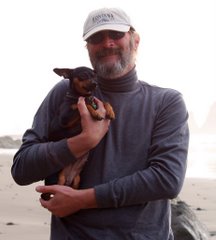
The Jonquils as they looked this morning
Taken 2/11/07
My internet friend Ed, in Columbus, Ohio, is the one person in my life who forces me to think about what I do when I shoot or edit pictures. Lots of people tell me to darken skies, straighten horizons, increase the color saturation, but only Ed asks me what I’m thinking when I select a particular scene. I’ve never met Ed in person, but I know that he has a background in Art History and has worked as a professional photographer. The type of questions he asks are the kind I would expect from an Art Historian. They are similar to the questions we asked in my literature classes at UC Berkeley.
Recently he responded to an image I sent him entitled “Homage to O’Keeffe III.” He was very complimentary concerning the Photoshop enhanced photograph and my skills, and I thank him for that, but then he started talking about composition, technique, equipment, and the “rules” of photography. I never responded to his e-mail, but I will do that now. And if any of you are interested in what goes into my submissions, please feel free to read over Ed’s shoulder. I’m sure he won’t mind.
As I get deeper into photography, I find that there are four different areas that intrigue me. The vast majority of my shooting involves landscapes or seascapes. I shoot a lot of birds. Architectural shots fascinate me, but I’m growing to love the art of portraying flowers—hence my Homage to O’Keeffe series. In my mind, flowers, birds, landscapes and buildings require four different approaches, both in shooting and in editing. I’d like to address each of those areas separately.
Architectural Photography

Jacksonville Oregon Presbyterian Church
As printed and scanned from original negative
Back in the 1980s I was struck by the Judith Basin County Courthouse in Stanford, Montana. Judith Basin County has 2,300 people crowded into 1,880 square miles. By my reckoning that’s not even one and a quarter people per square mile. Yet their courthouse, built in 1925, is a three story structure with a rotunda. It’s a very grand building for such a small place. As I traveled around Montana, I kept noticing how much money and effort went into these governmental buildings, most of which date from the late 1800s and early 1900s. I conceived of a project to be tied to Montana’s statehood centennial in 1989 where I would photograph each of the fifty-six county courthouses and put together a coffee-table book on these magnificent buildings. Unfortunately, I had neither the skill, the time nor the money to complete the project, but I did get a lot of interesting courthouse shots from around the state.
Photographing large buildings presents many challenges, not least of which is finding a point from which to capture as much of the building as possible. And since municipalities tend to frown on people tearing up shrubbery or removing signs, you get to deal with various distractions, most of which are going to end up on film or in the digital medium. Fortunately, photo editing programs are designed to handle such “distractions.” As an example of what I do, I offer two versions of the same shot of the Presbyterian Church in Jacksonville, Oregon. Driving through this historic town I was attracted by the design of the church and especially by the bright red tree on the corner of the church’s lawn. By the time I found a place to park, the moment had passed, the sun had moved on, and the lighting just wasn’t as compelling as it had been when I first saw the church. Nevertheless, I got out the Pentax, both lenses, and my Nikon L3 digital point and shoot. The top photograph shows the result (well, one of them). This is the unedited photograph taken from across the street. I dislike intensely hiding natural landscape elements, and rarely remove man-made objects from my landscapes. In this case, however, what I wanted to show was the church (and tree), and not a lot of pavement, wires, parking signs, etc. The first thing to do was to crop the photo to eliminate the expanse of street visible in the photograph. I also chose to “clone out” the wires crossing the front of the building and the parking sign directly in front of the church. All of these are distractions, and the wires especially tend to draw the eye away from the building itself. Finally I changed the lighting to approximate the scene that had first caught my eye. Whadda ya think? Is the image below more appealing than the one above? Maybe I should revisit the Montana Courthouses idea.

Jacksonville Presbyterian Church
As submitted to The Photographers' Workshop
Landscape Photography
In the case of landscapes, and by extension seascapes, I’m not as willing to eliminate the distractions. My first task is to frame the shot in the camera so as to avoid distractions. Shooting the sunrise on Friday I walked a couple of blocks to get a view of the sky unencumbered by power lines. If I cannot remove such elements in the photo shoot itself, then it feels dishonest of me to remove them in an editing program. Wires, for good or ill, are part of our environment now. They’re ubiquitous and it seems to me unreasonable to expect to see pristine landscapes when such no longer exist. Were I trying to recreate an historical period, it would be different, but if I’m showing you the Ship Ashore on US 101, you’re going to see the trailer houses, electric wires, and street signs that are a part of that particular landscape. As an example I give you the McCullough Memorial Bridge at Coos Bay, Oregon.

McCullough Memorial Bridge, Coos Bay Oregon
As downloaded from digital camera
I’ve posted this picture before in my blog on bridges, but here you get to see the original shot as well as the edited version. As you can see by looking at the two, there’s very little difference. I’ve adjusted the lighting and the color saturation. That’s all. I didn’t crop the photo, even though there’s a lot of water in front of the bridge, and I didn’t remove any elements by cloning or airbrushing. There’s a lot of water in Coos Bay, and it seemed appropriate to me to show that when preparing what is essentially a landscape shot that happens to have a bridge in it. This is the way I approach almost all of my landscape and seascape shots. The main exception is that if there happens to be a weed that popped up at the lower edge of the photograph, or if a tree or rock on one edge spoils the symmetry, I’ll crop or clone it out, depending on the image. But for the most part, all I do is lighten the shadows, darken the highlights, and add some color saturation so that the image presented comes closer to what I saw before lifting the camera.

McCullough Memorial Bridge
As Submitted to Eyefetch
Birds
I treat birds completely differently. Birds, as a rule, are so small that they rarely fill the frame. Furthermore, not being Audubon, I don’t feel free to kill the bird and then pose it the way I want it to appear. (Audubon did that—check your history.) So I’m faced with the problem of finding a bird in the wild (or in the wilds of my own back yard) and then trying to make a presentable image with what I’ve shot. This usually requires lots of cropping, enlarging, and even cloning so that the bird is presented in a natural way, but free of major distractions. I will say that some birds make this relatively easy. Gulls tend to congregate in parking lots where there aren’t a lot of distractions. The scrub jay seen here was not that cooperative. In this pair of images, again two versions of the same shot, you see the original of the jay high up in the bare beech tree in my back yard. Thank goodness for long lenses and lots of megapixels. I was able to discard virtually all of the original shot, leaving only the jay and the twigs immediately surrounding him. We expect to see birds in trees, shrubs, on power lines, etc, so I can crop most of that out and you’ll still have an honest shot, in my opinion. With mammals, on the other hand, I feel the necessity to leave some of the surrounding landscape. When I photographed the elk for my Alphabet 2006 book, I felt the need to leave the pasture land visible as well. (E is for Elk, don’t cha know.) It was what I’ve heard called an “environmental portrait.” As elk can be found in pastures, as I did, or in forests, or around here even on the beach, I felt it necessary to show just where I did find my wapiti.

Scrubjay in Tree
As downloaded from digital camera (above)
As submitted to Eyefetch (below)
Flowers
That brings us to flowers. I’ve been shooting flowers since the early 70s. You’ll find black and white 8 x 10 glossies of lilies, daisies, etc. in my first portfolio—pictures taken for a UC Berkeley Extension class in photography back in 1974. Flowers in black and white. Hmmm. Since I’ve been in Smith River I’ve been amazed at seeing flowers blooming every month of the year. You wouldn't think I grew up in California. I guess thirty plus years in Montana has made me forget that there are places where winter means the rain is cooler. Flowers have drawn my camera on an almost daily basis. As I organize my photographs by date, you’ll see roses, fuschia, pansies, azaleas, etc throughout the images I’ve taken over the past year. When the calla cluster in the back yard first drew my attention, and made me think of the paintings of Georgia O’Keeffe, I started learning photo manipulation in earnest. In “About Myself,” which O’Keeffe wrote in 1939, she talks about how flowers are so small that people don’t really see them. “If I could paint the flower exactly as I see it no one would see what I see because I would paint it small like the flower is small. So I said to myself—I’ll paint what I see—what the flower is to me but I’ll paint it big and they will be surprised into taking time to look at it—” O’Keefe’s One Hundred Flowers has become one of my favorite sources of inspiration. Looking at her interpretation of these dainty and delicate blossoms, I’ve honed my photoshop editing skills, working to extract the essence of the flower and then make it big. There is nothing dainty or delicate in O’Keefe’s flowers. I’m leaning toward producing the same effect.

Calla Lily
As Downloaded from digital camera (above)
As submitted to Eyefetch (below)

The first in my Homage to O'Keeffe series
So, Ed, I hope that begins to open my mind to you. I know I haven’t addressed all your questions, but I think that this is enough for now. Thank you for making me think about what I’m doing and why. Please keep on challenging me, pushing me, making me respond. I cherish your honesty and friendship. Should I ever have the opportunity to start shooting male nudes, I’ll be thinking of you as well.
Oh by the way, I’m heading east the end of March to visit family in West Virginia. Hope you won’t mind a visitor who’s passing through town.
 McCullough Memorial Bridge, Coos Bay Oregon
McCullough Memorial Bridge, Coos Bay Oregon











1 comment:
Thanks for sharing your and Ed's comments. It serves as an aid to us all.
Post a Comment